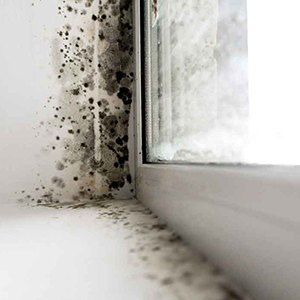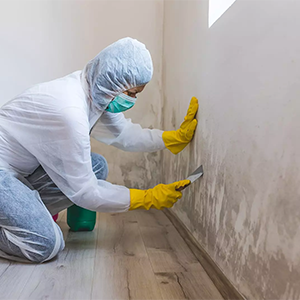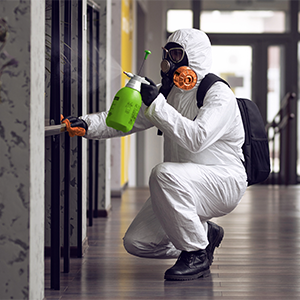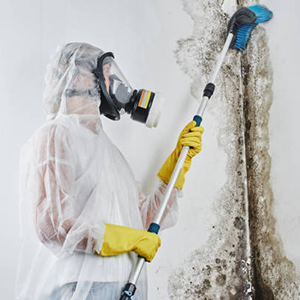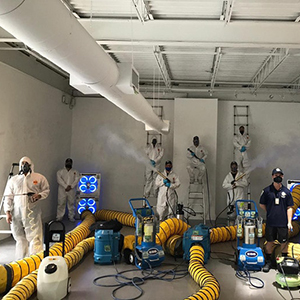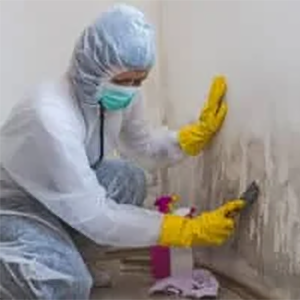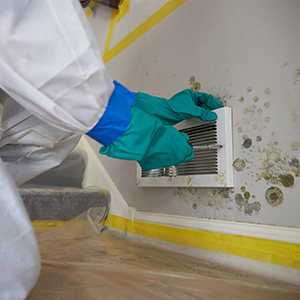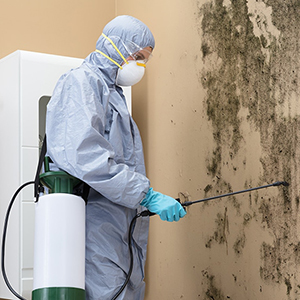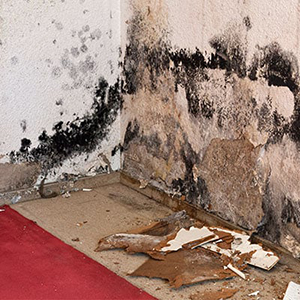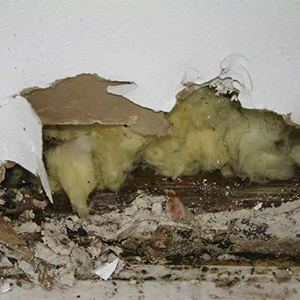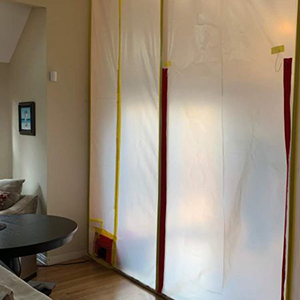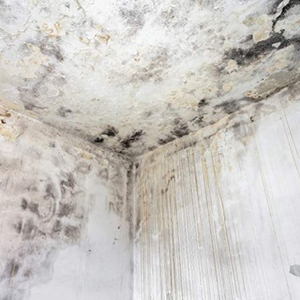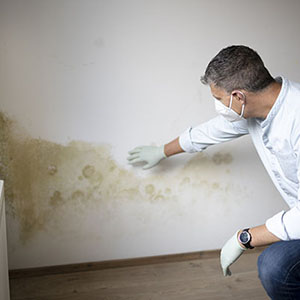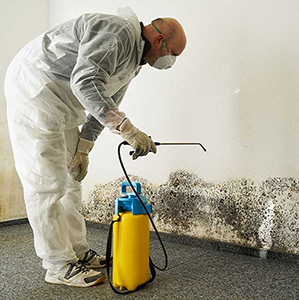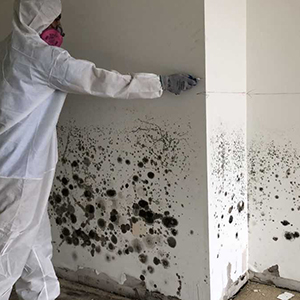While most homeowners are concerned about black mold removal, all types of mold can lower the air quality, create unpleasant smells, and cause numerous health problems—plus cause structural damage to the home.
Professional mold remediation typically costs $1,500–$9,000 with an average cost of $3,500. While you can clean small, visible mold problems yourself, it’s safer to call in the professionals for large or complex infestations.
Average Mold Remediation Cost
A small mold infestation can cost as little as $500–$1,000 to remove, but professional mediation for large problems can cost up to $30,000. Here are the primary factors that determine where your project will fall within that range.
- Mold location: The more difficult it is to get to and remove the mold, the more the project will cost.
- Size of affected area: The greater the size of the affected area, the higher the price.
- Mold type: A few mold types are more difficult and thus more expensive to remove.
- Labor: About 60% of the price of professional remediation efforts goes toward labor.
Cost by Mold Location
The location of the mold within your house has a large impact on cost, especially as it applies to how hidden or widespread the problem is.
Location Average Mold Removal Cost
Attic $1,000–$9,000
Basement $500–$4,000
Bathroom $500–$1,500
Crawl space $500–$2,000
Drywall $1,000–$12,000
HVAC system $3,000–$10,000
Whole house $10,000–$30,000
Attic
The cost to remove attic mold varies widely because of the nature of the space. Attics are large and lesser-used rooms, so you might not notice a roof leak until there’s visible mold. If the spot is small and the attic is easily accessible, removing it could cost as little as $1,000. However, the cost could be as high as $9,000 for extensive mold in cramped or difficult-to-access attics. If most of the mold is within the insulation, you’ll have to remove it, increasing the total price.
Basement
Basements have high humidity levels, so they’re susceptible to mold, particularly in summer. These rooms are similar to attics in that they can be very easy or difficult to work on depending on accessibility. Basement mold may cost $500–$4,000 to remove.
Bathroom
Bathrooms can be havens for mold because of the dampness created by bathing and showering. Visible surface mold is relatively inexpensive to remove and may cost no more than $500. If there’s a hidden plumbing leak and contractors need to tear out the cabinets and fixtures, though, you may pay up to $8,000.
Crawl Space
Mold in crawl spaces is very common for the same reason it tends to grow in basements. However, crawl spaces are typically much smaller, so the potential cost is lower, ranging from $500–$2,000.
Drywall
Drywall is the most common material that makes up indoor walls. This material is porous, so it can retain moisture. The drywall itself is fairly easy to repair, but water damage and mold on drywall are usually indicators of a larger problem such as a plumbing leak. Replacing moldy drywall can cost $1,000–$12,000. The cost will be on the higher end of the spectrum if the mold has been there for a while or grew through the drywall from the back, as this will require removing the drywall and everything behind it.
HVAC System
Costs for removing mold from an HVAC system depends on the system you have. Mold removal from radiant heating systems, which are mostly enclosed, is the least expensive at $1,500–$3,000. Furnace and air handler systems have more extensive air ducts and thus cost more, about $3,000–$5,000. Central air conditioners are the most expensive to remediate because they’re constantly removing moisture from the air and have a large number of vents, tubes, and ducts, so there are more potential trouble spots. These can cost up to $10,000 to clean.
Whole House
Whole-house remediation is typically only necessary after a catastrophic event such as a flood or a hurricane, and it can cost anywhere from $10,000–$30,000, depending on your home’s size and the extent of the damage.
Cost by Size of Affected Area
Professional mold remediation generally costs $10–$25 per square foot.
Size of Affected Area (in Square Feet) Cost Range
50 $500–$1,500
100 $1,000–$3,000
150 $1,500–$4,500
200 $2,000–$6,000
500 $5,000–$15,000
1,000 $10,000–$30,000
Cost by Type of Mold
The Environmental Protection Agency (EPA) doesn’t distinguish between mold species in its recommendations for mold cleanup. However, some types are more difficult to remove than others, so the cost of mold removal is determined by species to some extent.
Type Removal Cost
Alternaria $700–$6,000
Aspergillus penicillium $700–$6,000
Aureobasidium $1,500–$5,000
Chaetomium $600–$5,000
Cladosporium $700–$6,000
Fusarium $800–$8,000
Penicillium $1,500–$5,000
Serpula lacrymans $800–$7,000
Stachybotrys chartarum (black) $800–$7,000
Trichoderma (green) $700–$6,000
Ulocladium $1,500–$5,000
Alternaria
Mold of the genus Alternaria can trigger hay fever or allergy symptoms. Alternaria mold secretes toxins, but the effects of those toxins on humans and domestic animals isn’t well known. It falls within the average range to mediate at about $700–$6,000.
Aspergillus
Aspergillus mold species can directly infect human skin, contaminate food, and cause respiratory infections. The most common is A. fumigatus, which can potentially cause pneumonia or a group of diseases called aspergillosis. This is most common in immunocompromised people. Aspergiullus removal costs about $700–$6,000.
Aureobasidium
Aureobasidium mold such as A. pullulans and A. melanogenum thrive in freshwater and can irritate the respiratory system, even leading to a condition known as “humidifier lung.” These molds are described as black and yeast-like. They tend to grow slowly, so they’ll cost about $1,500–$5,000 to remove.
Chaetomium
There are many species of Chaetomium mold. Most can cause infections or allergic reactions in humans. C. atrobrunneum is especially dangerous to people with compromised immune systems, as it attacks the central nervous system. This species is dark gray to black and has a fuzzy appearance. It costs $600 to $5,000 to remove.
Cladosporium
Although Cladosporium molds are some of the most common, they rarely cause health problems in humans and can be removed for $700–$6,000. They don’t produce toxins, but do produce volatile organic compounds that create a musty odor and irritate allergy symptoms.
Fusarium
Fusarium is a large family of molds and fungi. Most are harmless, but some can cause infections in the nails and eyes. A few species may cause severe body-wide infections in immunocompromised people. This type is more expensive to remove—between $800 and $8,000—because it spreads so quickly.
Penicillium
Some types of Penicillium mold create the important antibiotic compound penicillin, and others are used in cheesemaking. When Penicillium infests your home, though, it can spread rapidly through the air even in low-humidity environments. It costs between $1,500 and $5,000 to remediate,
Serpula Lacrymans
- lacrymans causes dry rot in timber, where it reproduces rapidly and breaks down wood fibers. It damages structures more than it does people, but that’s all the more reason to remove it from your home quickly. Removal costs are slightly higher than average at $800–$7,000 because of how thoroughly the mold can spread through wooden structures.
Stachybotrys Chartarum
Many mold species are black, but when most people think of “black mold,” they think of S. chartarum. It can grow easily in drywall and wallpaper, making it one of the most common mold species in water-damaged buildings. It doesn’t release spores unless the mold is disturbed, so wearing respiratory protection is important. This is why S. chartarum costs a little more to remove, at $800–$7,000.
Trichoderma
Trichoderma fungi are fast-growing and may produce a sweet odor. The most common household species is T. longibrachiatum, a mold that starts out white and turns green-gray over time. It typically only causes health problems in people with allergies or lowered immune responses. It can be removed for $700–$6,000,
Ulocladium
Most Ulocladium species infect plants or cause food to spoil. However, some can trigger hay fever symptoms such as runny nose, sneezing, and itchy or watery eyes. Ulocladium typically costs the average of $1,500–$5,000 to remove.
Labor Cost
The above prices apply to hiring professional mold removal companies. Overall, labor accounts for about 60% of the total cost, with materials accounting for the other 40%. True mold remediation services involve much more than simple cleaning and removal—the area must also be sealed off to prevent mold spores from spreading.
Additional Cost Considerations
The following factors also contribute to mold remediation costs.
Repairing Damage
The mold remediation process typically doesn’t end when the mold is removed. Homeowners must then repair the damage and replace any removed materials, which factors into the total project cost. Here are some typical costs for repairs after a mold infestation.
- Cabinets: $120–$1,425 per linear foot
- Carpeting: $3.25–$10.25 per square foot
- Drywall: $50–$80 per square foot
- Hardwood flooring: $6–$18 per square foot
Preventive Measures
Once the mold issue has been resolved, it’s wise to take steps to prevent it from returning. Here are some preventive measures recommended by the CDC.
- Reduce humidity in your home: Try to keep humidity levels between 30% and 50% by using your air conditioner or dehumidifier in summer and thoroughly ventilating kitchens and bathrooms.
- Fix leaks immediately: Check pipes, roofs, and windows for leaks and fix them promptly.
- Remove carpet from humid areas: Carpeting in the bathroom or basement can hold onto moisture.
- Dry and fix water damage: If your home experiences water damage from a flood or severe storm, dry and clean it as soon as possible. Ensure everything is dry before painting or caulking.
- Schedule a mold inspection: If you’re worried the problem has come back, a professional mold inspector can point out trouble spots and recommend solutions. Inspections can cost $450–$800.
Mold Testing
Most of the time, there’s no need to test or sample to see which species of mold you have. All types of mold are potentially harmful, and although some produce toxins, the Center for Disease Control says all mold should be removed with equal care. If you want the mold tested because you’re experiencing specific health problems, it can cost $50–$700, depending on the test’s extensiveness.
How To Tell if You Need Mold Remediation
Visible black, green, or white mold on your home’s surfaces is an obvious sign that you need mold removal services. Here are some other indicators.
- Musty smell
- Recent water damage
- Spots, speckles, or fuzzy “island” growths on surfaces
- Unexpected or unseasonal allergy symptoms or other health issues
- Warping, peeling, or discolored paint or wallpaper
DIY vs. Professional Mold Remediation
If the moldy area is less than 10 square feet and you don’t have asthma or other sensitivities, the EPA says that it’s fine to remove mold yourself. Here’s what you can expect from both DIY and professional mold removal.
Professional Mold Remediation
If you’re hiring a professional, particularly if the problem is severe, look for a mold remediation specialist. They’ll typically take the following steps to minimize health risks to you and your family.
- If any moldy areas are still actively wet, they’ll dry them with dehumidifiers and fans before beginning work. Any leaks will need to be fixed.
- Mold remediators seal off the area with plastic sheeting, using filtration devices and negative air pressure to prevent the spread of spores.
- Air scrubbers fitted with HEPA filters clean the air as mold-damaged materials are destroyed and removed.
- Contractors clean all hard surfaces with antifungal and antimicrobial cleaners. Soft surfaces and porous materials must usually be thrown away.
- If the musty smell persists, remediators will use a dry fogger to remove it.
The benefit of hiring a mold remediation company is that you know the job will be done thoroughly, quickly, and safely. True remediation involves more than just removing visible mold, and pros know where to look to see if the problem has spread to hidden areas. The downside is price, as professional mold removal usually costs thousands of dollars.
DIY Mold Remediation
Here’s what the EPA and CDC recommend if you want to remove mold yourself.
- Fix leaks or other sources of water damage first.
- Remove standing water with a shop vac and open all doors and windows.
- Protect your mouth and nose with a high-filtration mask, such as an N95. Wear gloves and goggles to protect eyes and skin.
- Scrub hard surfaces with cleanser. You can use bleach diluted at a ratio of one cup of bleach to one gallon of water, but never mix bleach and ammonia.
- Dispose of soft or porous materials such as drywall, carpeting, or ceiling tiles. If the mold has spread to an expensive or sentimental soft item, take it to a restoration specialist.
- Dry all surfaces quickly after cleaning.
Cleaning up mold and mildew is time-consuming, and while you’ll save money on labor, you may start and then see the problem is bigger than you realized. Moldy areas bigger than about 3-feet-by-3-feet should usually be removed and cleaned by professionals. Additionally, consult a professional if you think any mold has gotten into your HVAC system before turning it on—this isn’t something you can clean yourself.
How To Hire a Professional
You may need to ask more detailed questions than you would another type of contractor when choosing a mold remediation specialist.
- Do your contractors have mold remediation certification or other kinds of specialty abatement licensing?
- Are you bonded and insured with mold-specific insurance?
- Is inspection and testing included in the cost?
- How will you protect the rest of my home from mold spores?
- Which steps of the process are included in the contract?
- How much restoration work do you do?
- How long will this project take? Can I (and my family) stay in the house during that time?
How To Save on Mold Remediation
Here are some ways to save money on mold remediation, even if you hire a professional.
- Prevent mold growth by repairing leaks and drying water damage quickly.
- Contact your insurance company to see whether your homeowners insurance covers mold removal, particularly after a catastrophic event.
- Do as much of the cosmetic restoration work, such as painting and tiling, as you can after the removal is complete.
- Request cost estimates from at least three local specialists. Be wary of any who charge much more or less than the others.
Our Conclusion
You can and should clean small areas of mold yourself with some protective gear and good cleansers. However, it’s best to hire a mold remediation specialist for large mold problems, mold in the walls, or if you or someone else in your home has respiratory problems. Remediators know how to remove mold-damaged building materials without spreading spores, helping keep you and your family safe.
Our Mold Remediation Process
When a mold infestation takes over a residential or commercial building, property owners often call a restoration company specializing in the mold remediation process. Learn more about our 6-step mold remediation process here.
1.Find the source of the moisture.
2.Seal off the contaminated area.
3.Supress dust.
4.Reduce moisture using HEPA air scrubbers and dehumidifiers.
5.Clean all materials.
6.Restore the damaged area.
After we complete this process, we can also perform other cleaning services including carpet cleaning and duct cleaning. With your health as our top priority, we want to ensure all possible mold spores are removed.
Our Comprehensive Mold Remediation Services
While it is tempting to ignore mold growth, it can be detrimental to your health. According to the CDC (Centers for Disease Control), mold can not only cause allergy-like symptoms but has been found to cause upper respiratory illnesses such as asthma in otherwise healthy individuals.2
Another reason it’s imperative to hire a professional mold remediation company like Group 247 is because sometimes mold-like growth or musty smells are mildew and not as harmful and can be cleaned easily. Our team uses mold testing technology to determine if the mold is dangerous and our lab will even help determine the species of mold if necessary.
But mold remediation does not have to be detrimental to your bank account or a complete reconstruction project. We provide free quotes and work quickly to get your project completed so your home will be back to safe, working order in as little time as possible.
Common Mistakes in DIY Remediation
Mold is common in certain climates and certainly the sometimes toxic spores will grow under the proper circumstances. There are over 300,000 types of mold. The most important criteria for removing mold is knowing if the mold is airborne or not. A common mistake is trying to remove mold and causing it to spread in the air through ventilation and fan circulation. Our professional mold remediation strategy includes identifying the type of mold (is it airborne, toxic, restricted to one area of growth) and making sure steps are taken to clean the air and remove the mold infested surfaces and materials.
Another common mistake is hiring a mold remediation company based on cost alone. One very common practice in mold remediation is chemical bombing to kill mold or relying on bleach alone to remove mold growth. While this technique is effective in the short term, ANY remaining spores will repopulate and grow back in a rather short amount of time. The most effective mold remediation process is one that scrubs and purifies the air, removes the mold contaminated surfaces even as far down to insulation. Our thorough approach ensures complete mold removal. We guarantee our mold remediation and will come back if ever you’re not fully satisfied.
- We restore homes and businesses suffering from water damage! We can remove water or anything damaged by water. We also treat mold and offer comprehensive water damage restoration services.
- For emergency situations, we have technicians ready to be dispatched and can be at your home or business within 45 minutes to start the water extraction.




